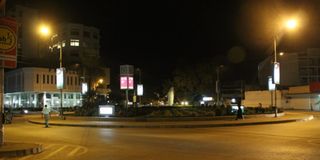Prime
Let there be light: The case for street lights in Tanzania

What you need to know:
- By prioritising the installation of street lights and embracing modern With these technologies, Tanzania can harness the power of light to tranform its urban land and unlock immense social and economic benefits.
In Tanzania, the stark absence of street lighting is an issue that demands urgent consideration.
A quick online search for street lights in Tanzania predominantly yields results for lamp merchants.
Only with persistence might one stumble upon a project to install a mere 80 sets of road lights in Mwanza in 2022, which, surprisingly, made headlines.
Yes, 80 sets. That’s the sort of stuff that makes news in Tanzania.
This glaring oversight underscores a pervasive problem: while we have tirelessly been constructing new roads, we have completely ignored the need to illuminate our streets and public spaces.
As a result, darkness reigns across the land. I think Arusha epitomises this predicament. I spent 10 years of my life in Arusha, and it is by far, my favourite city in Tanzania
The last time I was in Arusha, I spent hours travelling around, shooting pictures, and soaking in every ounce of beauty.
In Arusha, the perfect blend of temperate weather, lush green scenery, and a touch of exotic Maasai culture creates a truly enchanting atmosphere.
But Arusha’s undeniable charm masks its one big flaw – the city goes to sleep so early each night. Many shops, even those within the CBD, start to lock their doors when the sun sets.
Last time I went to visit the Cultural Heritage at 5.30 pm and the place was closed.
By 9 p.m., bars apart, one would really struggle for places to visit.
One may blame waves of criminal activity that engulfed northern regions a while ago, but the lack of street lighting has a lot of bearing on that.
Research indicates that well-lit streets lead to a 20 percent drop in crime rates, a 35 percent reduction in accidents, and a boost in economic activity.
I observed that boost lately when I traversed the newly illuminated Shekilango Road in Sinza well past midnight.
This road project not only included street lights but also pedestrian pavements, sparking a remarkable resurgence in the area.
With improved store quality,extended business hours, and soaring new construction, Sinza is swiftly evolving into a thriving mixed residential and business district, benefiting residents, property owners, and tax collectors alike.
Sinza serves as a compelling case for normalising street lighting for all our streets, public spaces, and pavements in all cities around the nation. It is evident that light possesses the power not only to rejuvenate our cities but also to supercharge our economy.
Taking Dar es Salaam as an example, with approximately 500 kilometres of paved roads, the
The installation of an estimated 40,000 street lights, costing around 50 billion shillings, promises immense returns, particularly beyond illumination.
Firstly, the project can generate significant revenues for Tanesco.
Assuming lights that require 400KWh of energy annually, the project will generate about $5 billion every year, or $100 billion over the project’s 20-year lifetime.
Now, while some people may think it is cool to have solar-powered lights for some reason, importing tens of thousands of solar panels only benefits the suppliers, not Tanzanians.
To maximise the benefits, use local resources. Secondly, street lamp infrastructure can serve a dual purpose by facilitating the distribution of internet services.
The crude wooden poles with black cables on top that are currently in use make Dar look like a city inhabited by cavemen.
However, steel lamp posts would address that, providing not just aesthetics but decreasing CAPEX through infrastructure sharing, OPEX through proper planning, and ultimately making the internet not only faster and cheaper, but also more reliable.
Thirdly, the implementation of smart lighting systems, controllable through digital technology, will require 40,000 4G/5G broadband connections and therefore generate billions in revenues for operators.
Furthermore, these lamp posts can become the backbone of a modern, efficient urban ecosystem, supporting traffic monitoring, public Wi-Fi, 5G deployments, revenue collection, CCTV, and much more.
Fourthly, until now, we have mostly been importing lights and steel poles.
But the proposed increase in scale provides a compelling business case for foreign manufacturers to establish factories right here in Tanzania, thus multiplying economic opportunities and fostering economic growth.
Countries such as Argentina have already capitalised on that strategy, and I understand that Rwanda is on the way to achieving the same thing soon.
As can be seen, there is quite a lot to say. Put together, we are talking about a sector with potentially hundreds of billions of dollars of value that will be unlocked simply by doing what we should have been doing from the beginning.
A project like this will most likely pay itself off within a couple of years while providing new employment for thousands of youth.
In conclusion, the absence of adequate street lighting in Tanzanian cities is a pressing issue that demands immediate attention.
Beyond mere illumination, it represents an opportunity to enhance security, boost economic activity, and pave the way for more connected and smart cities.
By prioritising the installation of street lights and embracing modern With these technologies, Tanzania can harness the power of light to tranform its urban land and unlock immense social and economic benefits.
So, let there be light!





